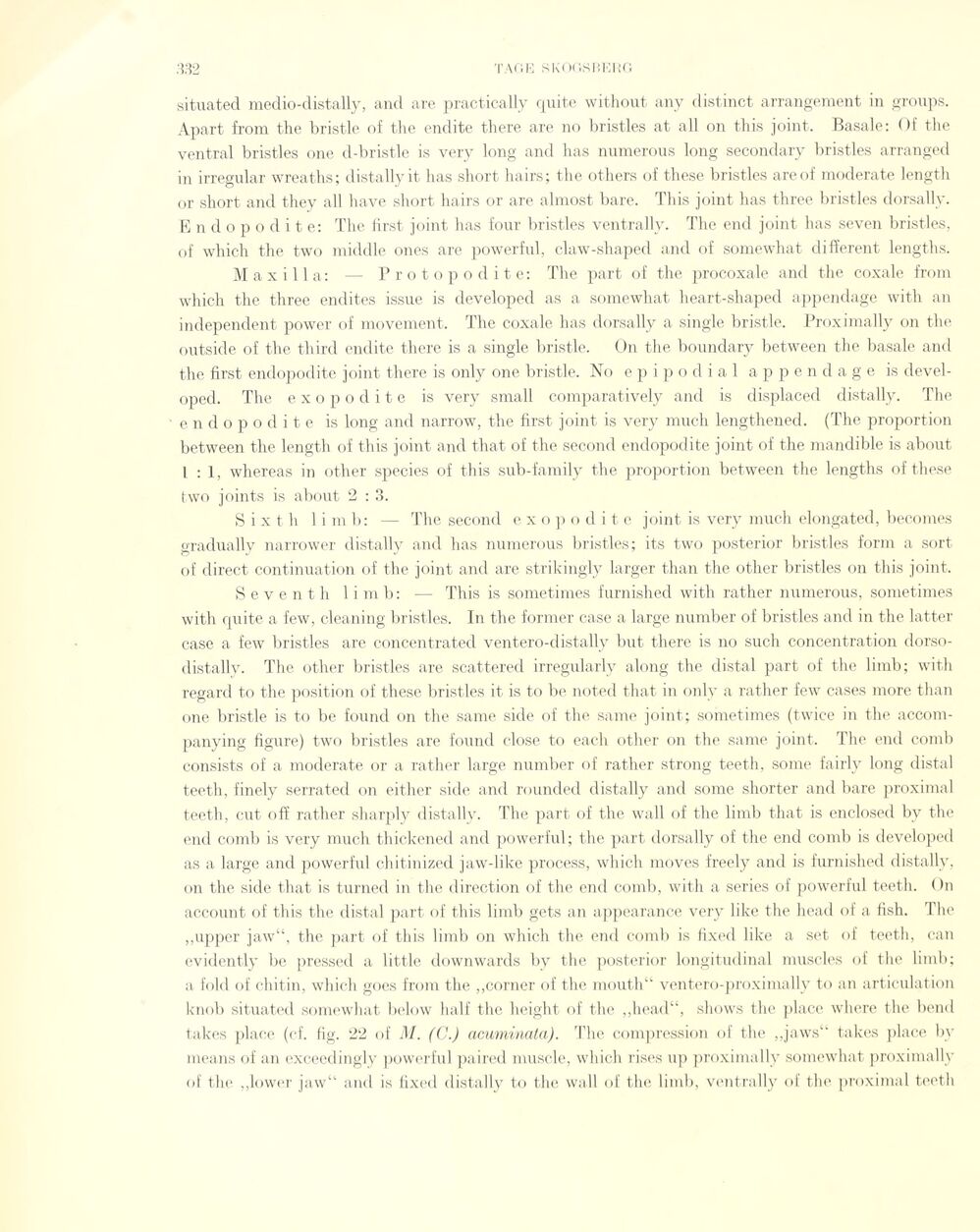
Full resolution (JPEG) - On this page / på denna sida - Sidor ...

<< prev. page << föreg. sida << >> nästa sida >> next page >>
Below is the raw OCR text
from the above scanned image.
Do you see an error? Proofread the page now!
Här nedan syns maskintolkade texten från faksimilbilden ovan.
Ser du något fel? Korrekturläs sidan nu!
This page has never been proofread. / Denna sida har aldrig korrekturlästs.
situated medio-distally, and are practically quite without any distinet arrangement in groups.
Apart from the bristle of the endite there are no bristles at all on this joint. Basale: Of the
ventral bristles one d-bristle is very long and has numerous long secondary bristles arrangée!
in irregulär wreaths; distallyit lias short liairs; the others of these bristles areof moderate lengtli
or short and they all have short hairs or are almost bare. This joint has three bristles dorsally.
Endopodite: The first joint has four bristles ventrally. The end joint has seven bristles,
of which the two middle ones are powerful, claw-shaped and of somewhat different lengths.
Maxilla: — Protopo dite: The part of the procoxale and the coxale from
which the three endites issue is developed as a somewhat heart-shaped appendage with an
independent power of movement. The coxale has dorsally a single bristle. Proximally on the
outside of the third endite there is a single bristle. On the boundary between the basale and
the first endopodite joint there is only one bristle. No epipodial appendage is
developed. The exopodite is very small comparatively and is displaced distally. The
endopodite is long and narrow, the first joint is very much lengthened. (The proportion
between the length of this joint and that of the second endopodite joint of the mandible is about
1:1, whereas in other species of this sub-family the proportion between the lengths of these
two joints is about 2 : 3.
S i X t h 1 i m b: — The second exopodite joint is very much elongated, becomes
graduallv narrower distally and has numerous bristles; its two posterior bristles form a sort
of direct continuation of the joint and are strikingly larger than the other bristles on this joint.
Sevent h li mb: -— This is sometimes furnished with rather numerous, sometimes
with quite a few, cleaning bristles. In the former case a large number of bristles and in the latter
case a few bristles are concentrated ventero-distally but there is no such concentration
dorso-distally. The other bristles are scattered irregularly along the distal part of the limb; with
regard to the position of these bristles it is to be noted that in only a rather few cases more than
one bristle is to be found on the same side of the same joint; sometimes (twice in the
accom-panying figure) two bristles are found close to each other on the same joint. The end comb
consists of a moderate or a rather large number of rather strong teeth, some fairly long distal
teeth, finely serrated on either side and rounded distally and some shorter and bare proximal
teeth, cut off rather sharply distally. The part of the wall of the limb that is enclosed by the
end comb is very much thickened and powerful; the part dorsally of the end comb is developed
as a large and powerful chitinized jaw-like process, which moves freely and is furnished distally,
on the side that is turned in the direction of the end comb, with a series of powerful teeth. On
account of this the distal part of this limb gets an appearance very like the head of a fish. The
„upper jaw“, the part of this limb on which the end comb is fixed like a set of teeth, can
evidently be pressed a little downwards by the posterior longitudinal muscles of the limb;
a fold of chitin, which goes from the „corner of the mouth“ ventero-proximally to an articulation
knob situated somewhat below half the height of the „head“, shows the place where the bend
takes place (cf. fig. 22 of M. (C.) acuminata). The compression of the „jaws“ takes place by
means of an exceedingly powerful paired muscle, which rises up proximally somewhat proximally
of the „lower jaw“ and is fixed distally to the wall of the limb, ventrally of the proximal teeth
<< prev. page << föreg. sida << >> nästa sida >> next page >>